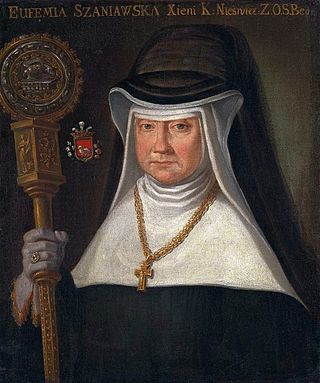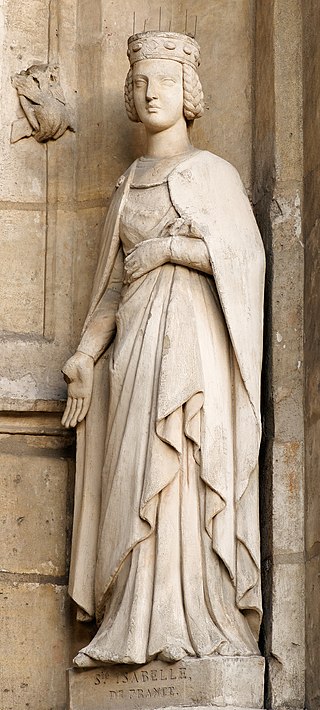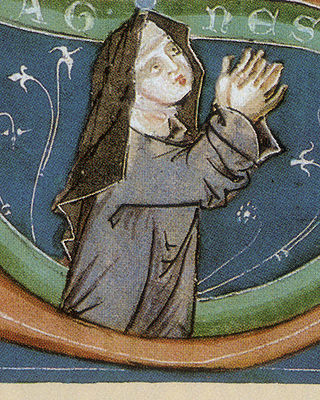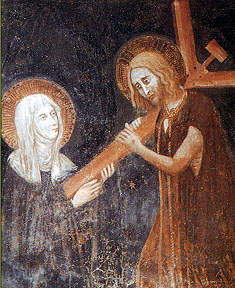
An abbess is the female superior of a community of nuns in an abbey.

Scholastica was an Italian Christian hermit and the sister of Benedict of Nursia. She is traditionally regarded as the foundress of the Benedictine nuns.

Venantius Honorius Clementianus Fortunatus, known as Saint Venantius Fortunatus, was a Latin poet and hymnographer in the Merovingian Court, and a bishop of the Early Church who has been venerated since the Middle Ages.

Radegund was a Thuringian princess and Frankish queen, who founded the Abbey of the Holy Cross at Poitiers. She is the patroness saint of several churches in France and England and of Jesus College, Cambridge.

A double monastery is a monastery combining separate communities of monks and of nuns, joined in one institution to share one church and other facilities. The practice is believed to have started in the East at the dawn of monasticism. It is considered more common in the monasticism of Eastern Christianity, where it is traceable to the 4th century. In the West the establishment of double monasteries became popular after St. Columbanus and sprang up in Gaul and in Anglo-Saxon England. Double monasteries were forbidden by the Second Council of Nicaea in 787, though it took many years for the decree to be enforced. Double monasteries were revived again after the 12th century in a significantly different way when a number of religious houses were established on this pattern among Benedictines and possibly the Dominicans. The 14th-century Bridgittines were purposely founded using this form of community.

May 12 - Eastern Orthodox Church calendar - May 14

Isabelle of France was a French princess and daughter of Louis VIII of France and Blanche of Castile. She was a younger sister of King Louis IX of France and of Alfonso, Count of Poitiers, and an older sister of King Charles I of Sicily. In 1256, she founded the nunnery of Longchamp in part of the Forest of Rouvray, west of Paris. Isabelle consecrated her virginity and her entire life to God alone. She is honored as a saint by the Franciscan Order. Her feast day is 26 February.

Agnes of Bohemia, O.S.C., also known as Agnes of Prague, was a medieval Bohemian princess who opted for a life of charity, mortification of the flesh and piety over a life of luxury and comfort. Although she was venerated soon after her death, Agnes was not beatified or canonized for over 700 years.
Basina, was a Frankish princess, the daughter and youngest child of Chilperic I, King of Soissons, and his first wife, Audovera. After surviving the assassination of her immediate family, she became a nun. She later helped to lead a rebellion by a group of the nuns, which became a scandal throughout the region. This event was chronicled by the bishop and saint, Gregory of Tours, who was one of the bishops chosen to settle the matter.

Clare of Montefalco, OSA, in religion Saint Clare of the Cross, was an Augustinian nun and abbess. She was formerly a member of the Third Order of St. Francis. She was canonized by Pope Leo XIII on December 8, 1881.

Erentrude was a saint and abbess, born during the end of the 7th century, probably in present-day Germany or Austria. She was born into a Franconian-Merovingian royal house, and was the niece of Rupert of Salzburg. She left her home country to assist Rupert in establishing religious communities in Salzburg; in about 700, he built a convent, Nonnberg Abbey, and installed her as its first abbess. She and the nuns at Nonnberg served the poor, needy, and ill, striking a balance between living as cloistered nuns and engaging in charitable works. Erentrude died on 30 June 718. Her fame for healing miracles and intercession grew after her death, and many legends have arisen throughout the centuries since her death. In 2006, Erentrude's image appeared on the Austrian Nonnberg Abbey commemorative coin. Her feast day is celebrated on 30 June.

Opportuna of Montreuil was a Frankish Benedictine nun and abbess. A Vita et miracula Sanctae Opportunae was written within a century of her death by Adalhelm, bishop of Séez, who believed he owed his life and his see to Opportuna.

The Church of Sainte-Radegonde is a medieval Roman Catholic church in Poitiers, France, dating from the 6th century. It takes its name from the Frankish queen and nun, Radegund, who was buried in the church. Considered a saint, the church became a place of pilgrimage by those devoted to her heavenly intercession. The current church, constructed from the 11th to 12th centuries, was built in a combination of Romanesque and Angevin Gothic architectural styles.
Baudonivia was a nun and hagiographer at the convent of Holy Cross of Poitiers. Very little is known about her. She wrote a biography of Radegund, Queen, founder of Holy Cross, and saint. Scholars have noticed a marked difference in perspective between an earlier life of Radegund composed by Venantius Fortunatus, written from a close friend's perspective, and Baudonivia's, written from the perspective of a nun of Radegund's own convent.

St Radegund's Priory, Cambridge was a Benedictine nunnery in Cambridge, Cambridgeshire, England. It was founded before 1144 and dissolved in 1496 by the initiative of John Alcock, Bishop of Ely.

The Abbey of the Holy Cross was a French Benedictine nunnery founded in the 6th century. Destroyed during the French Revolution, a new monastery with the same name was built in a nearby location during the 19th century for a community of Canonesses of St. Augustine of the Mercy of Jesus.
Caesaria the Elder or Caesaria II was a saint and abbess. Little is known about her, but there were some "glowing" references to her in the writings of Venantius Fortunatus; according to Gregory of Tours, her life was "blessed and holy". She was born in a Gallo-Roman family and was trained at John Cassian's foundation in Marseilles.

The Abbey of St Caesarius, at first called the abbey or monastery of St John, was a nunnery in the city of Arles in the south-eastern corner of the rampart. It was founded in 512 AD by Saint Caesarius of Arles, after whom it is now named. The abbey was suppressed in the French Revolution. Those that remained of the buildings were later used as a hospice; they are now adandoned.
Maroveus was the bishop of Poitiers in the late sixth century. He became bishop between 565 and 573, serving until sometime between 590 and 594.
Caesaria the Younger or Caesaria II was the abbess of Saint-Jean d'Arles from around 525 until her death.















